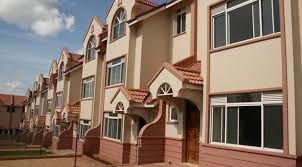Uganda has an immense market potential for housing delivery in the affordable market segment, according to a continental think tank- Centre for Affordable Housing Finance in Africa (CAHF). With the widening gap in annual housing supply compared to the established demand, developers could exploit the significant opportunity in the affordable housing segment. There is insufficient supply of housing units for most low income earners, adds CAHF in its 2019 Yearbook.
Additionally, stability in market lending interest rates has encouraged an upsurge in mortgage finance for the past two years and further availability of low-cost finance may increase uptake further.
The document notes the 2019/20 national budget highlights key opportunities towards easing limitations to accessing loans through the proposed enactment of Security Interest in Movable Property Act. This, it says, will allow the use of movable assets as loan collateral. “Once enacted, finance providers, mainly in the micro-mortgage space, are likely to see an increase in the number of loan applicants who are currently restricted by lack of suitable collateral. Ultimately the increasing access to finance, coupled with significant housing demand, should present ample opportunity for housing delivery in the affordable segment of the market.”
The document cites Housing Finance Bank (HFB) as leading the mortgage financing market segment in Uganda with about 55 percent of the total mortgage portfolio in the country. Other banks involved in housing related finance include Bank of Africa, Standard Chartered Bank, dfcu Bank, Stanbic Bank and Centenary Bank.
The total mortgage portfolio, comprising both residential and commercial mortgages, increased by 10 percent to USh2.92 trillion (US$790.3 million) in June 2019. The growth is largely attributed to a stability in bank interest lending rates and economic recovery that supports investments across most sectors.
Average mortgage lending rates have marginally declined to 17 percent as of June 2019, from 17.5 the previous year and 19.5 percent in 2017. The decline in mortgage interest rates is largely attributed to increasing levels of competition among lenders and a low inflation rate. Although the decline in lending interest rates is notable across the last two years, the cost of borrowing remains a major constraint to accessing credit in the country, mainly due to a low-level supply of long-term finance to support mortgage lending and high levels of provisioning for defaults as required by the regulator.
Additionally, the savings’ culture in Uganda is relatively underdeveloped, with only about 54 percent of the adult population saving regularly. This is due to low income levels, averaging US$647 GDP per capita, and a relatively high cost of living.21 However, with the recent increase in bank agent outlets and expansion of microcredit, the level of financial inclusion has improved significantly to 78 percent in March 2018 from less than 50 percent over 10 years ago.
The National Social Security Fund (NSSF) records the country’s saving rate at 11 percent, a large impediment to long-term development. However, the new NSSF Amendment Bill (2019) seeks to achieve a saving rate of 40 percent over the next 30 years. This is to be achieved through a combination of sustained high growth rates, relaxation of corporate contribution regulations, and up to 30 percent tax-free savings allowances for workers.
Lenders must factor provisions for expected loan losses into their loan pricing, and this risk affects the cost of borrowing. However, with a notable improvement in asset quality, as measured by the ratio of non-performing loans to total outstanding loans (NPL ratio), to 3.8 percent in March 2019 from 5.3 percent in March 2018, the lending interest rates across most business segments have recorded a downward trend and translated into the 9.3 percentage expansion in credit to the private sector.
Affordability
Affordability of housing is still a major challenge for most households. Approximately 20 percent of households in the Kampala area live in their own houses, with 80 percent living in rented apartments. For other urban areas, the ratio of owner-occupation increases to 44 percent and reaches a high of 83 percent in rural areas. The key constraints to housing affordability include the high cost of completed housing units and the high cost of borrowing for housing finance.
Over the one-year period to January 2019, rising land and input prices have driven residential property prices upwards by 2.5 percent highlighted in the Retail Property Price Index movement. Additionally, the Construction Sector Indices highlight a 2.0 percentage rise in construction sector input prices for the same period.
This rise in input prices translates into high prices for completed housing units and further suppresses housing affordability for the majority workers dependent on employment in the agriculture value chain.
Uganda’s agriculture sector is characterised by low income levels but still occupies a lion’s share in employing the country’s population. Although employment in agriculture accounted for 71 percent of employment in 2018, the sector did not offer sufficient income for its workforce to afford decent accommodation.
On average, a newly completed two-bedroom house sells for about Shs50 million, (US$13 532), which is beyond the reach of most Ugandans. Using formal income levels, only 4.4 percent of Uganda’s urban population have the purchasing power to afford the cheapest newly built three-bedroom house valued at US$20 000 (USh74 million).
More specifically, housing units priced within the range of USh50 million and Shs70 million are outside the main GKMA urban areas and normally require prospective homeowners to combine both formal and informal income sources to afford such units.
On the financing side, most lenders only offer up to 80 percent financing for residential mortgages. This makes it impossible for the bulk of prospective homeowners to raise the remaining 20 percent to qualify for home financing, given the low level of savings among the population.
In addition, borrowing interest rates have remained relatively high at 17 percent per annum across most lenders.
To overcome this affordability challenge, some banks, including HFB and Bank of Africa, have introduced 100 percent financing for residential mortgages under which borrowers may be fully financed without down payments to acquire residential property. HFB has also introduced incremental housing finance under which a client can take small loans to build a house in phases, thereby reducing the burden of a large mortgage.
Housing supply
According to the Uganda Bureau of Statistics, Uganda has a deficit of 2.1 million housing units, growing at a rate of 200 000 units a year.27 In 2030, the deficit is expected to reach three million units. This is on account of the rapid urbanization rate and a high population growth rate of 3.2 percent per annum. This rate of that continues to seriously impact the country’s housing sector.
While more housing units are needed, construction costs are still high, as reflected by the rising
Construction Sector Indices discussed in the Affordability section. The NSSF, with an asset base of USh11 trillion (US$2.98 billion), though passionate about the sector, has failed to construct a residential unit below USh100 million (US$27 063). The high cost of construction makes delivering at an affordable price point challenging. The cost of land is also high, estimated at USh880 000 (US$239) per square meter in urban areas.
Labour
While labour to construct a house might be relatively affordable at approximately USh3 700 (US$1) per square meter, this is eroded by the high cost of land and infrastructure.28 For affordable housing, where the threshold is considered USh100 million (US$27 063),29 a developer like NSSF would need free urban land and already existing supporting infrastructure.
Small-scale developers have delivered housing units within this pricing range outside of the GKMA area. Prefabricated houses, which the NSSF has experimented with in a bid to lower housing costs, met low levels of acceptability. This indicates a preference for brick and mortar homes by the general population.
On the supply side, the country has registered progress in expanding the delivery of housing units for the rapidly rising population. Less than 15 mid-sized property developers are cumulatively delivering close to 700 housing units (typically freehold condominium) in the GKMA area annually.
In 2018 and 2019, the government differed from the norm of leaving housing development to private sector market participants, delivering 101 housing units to families evacuated from the landslide prone Mount Elgon region in the East of the country. The two-bedroom housing units were constructed by the national army and police under the first phase completed in March 2019. The second and third phases will focus on delivery of 400 and 900 houses respectively for occupation by 6 300 people affected by landslides in the region.
In October 2018, HFB, partnered with Habitat for Humanity and the Buganda Kingdom to champion the Decent Living Campaign. This is initiative is aimed at improving lives through decent shelter, better livelihoods, access to safe and clean water, and better hygiene and sanitation, with an overall goal of supporting close to 400 individuals by 2030. Social housing will be needed to eliminate housing poverty in Uganda.
Property markets
Uganda’s property market is dominated by a handful of property developers with capacity to deliver over 100 units per annum each. Currently, this space has been taken up by National Housing and Construction Company, Comfort Homes, Universal Multipurpose Enterprises and Waves Limited. These tend to set benchmark market prices for housing units within the Greater Kampala Metropolitan Area. A few other small-scale developers, delivering under 20 units per annum, deliver the units at prices close to market rates.
Beyond delivery of new houses, several transactions do take place on the secondary housing market. The key driver of the secondary housing market tends to be loan recovery for borrowers who have had difficulties meeting their loan installments on mortgaged property.
On the rental market side, approximately 22 percent of urban dwellers live in rented apartments in areas within and around Uganda’s capital city. The percentage of owner-occupation improves with areas further away from the city to reach 91 percent in rural northern Uganda. On the property registration side, the World Bank ranks Uganda at 126 out of 190 countries, with 42 days required to complete a 10-step process costing 3.1 percent of the land value.
Property rights are an additional barrier to providing affordable housing. About 80 percent of land in Uganda is under a customary land tenure system, making it difficult for an individual to pledge such communal land as collateral for personal mortgage-related borrowing.
Land fragmentation in densely populated areas also affects housing delivery. Challenges also arise from the small, untradeable land parcels and large undeveloped land, especially crown land. The solution is to either develop or tax the land. The property market is significantly affected by the increase in lending interest rates, resulting from the banks’ high cost of funding and operating costs.
Creation of alternative funding structures to support long-term bank lending would be an appropriate solution for the sector. Uganda’s Ministry of Finance, Planning and Economic Development has established committees to finalise arrangements for setting up a mortgage refinance company and to operationalise the regulations for pension-backed mortgages. In 2012, Uganda’s land registry introduced a computerised land title recording and issuance system, aimed at easing the titling of property, registration of land and generally improving land administration. The initiative is likely to improve the proportion of titled land earlier recorded at 20 percent across the country.
Policy and regulation
Since the business of real estate engages multiple stakeholders such as banks, landlords, property managers and tenants, action by one party inevitably impacts on the performance of another stakeholder. Several regulatory changes affecting the housing and real estate sector have therefore taken effect in 2019.
In June 2019, Uganda’s Parliament passed the Landlord and Tenant Bill of 2018 that seeks to, among other things, regulate the relationship between landlords and tenants. This Bill, awaiting the president’s consent, has several amendments on rights and duties of landlords and tenants in rented commercial and residential premises. A key provision of the Bill includes the legal requirement for the two parties to execute a contract for all rent transactions above value of USh500 000 (US$135) with clear terms and conditions.
Additionally, it is now illegal for landlords to evict defaulting tenants without securing court orders to do so.
The Financial Institutions (Capital Adequacy Requirements) Regulation, 2018 took effect in September 2018. This enhanced the capital requirements for financial institutions, with the aim of improving commercial bank’s resilience to market and operational risks. With this amendment, financial institutions are now required to hold additional capital as a cushion for market risk. The minimum on-going Tier 1 capital/risk weighted assets (RWA) requirement was increased to 10 percent. This will affect the banks’ ability to offer large-scale loans to clients including property developers.
CAHF is a DFID funded think tank that aims to find ways to make financial markets work for the poor. A large part of their research looks at how accessible housing finance truly is, particularly for the poor.







